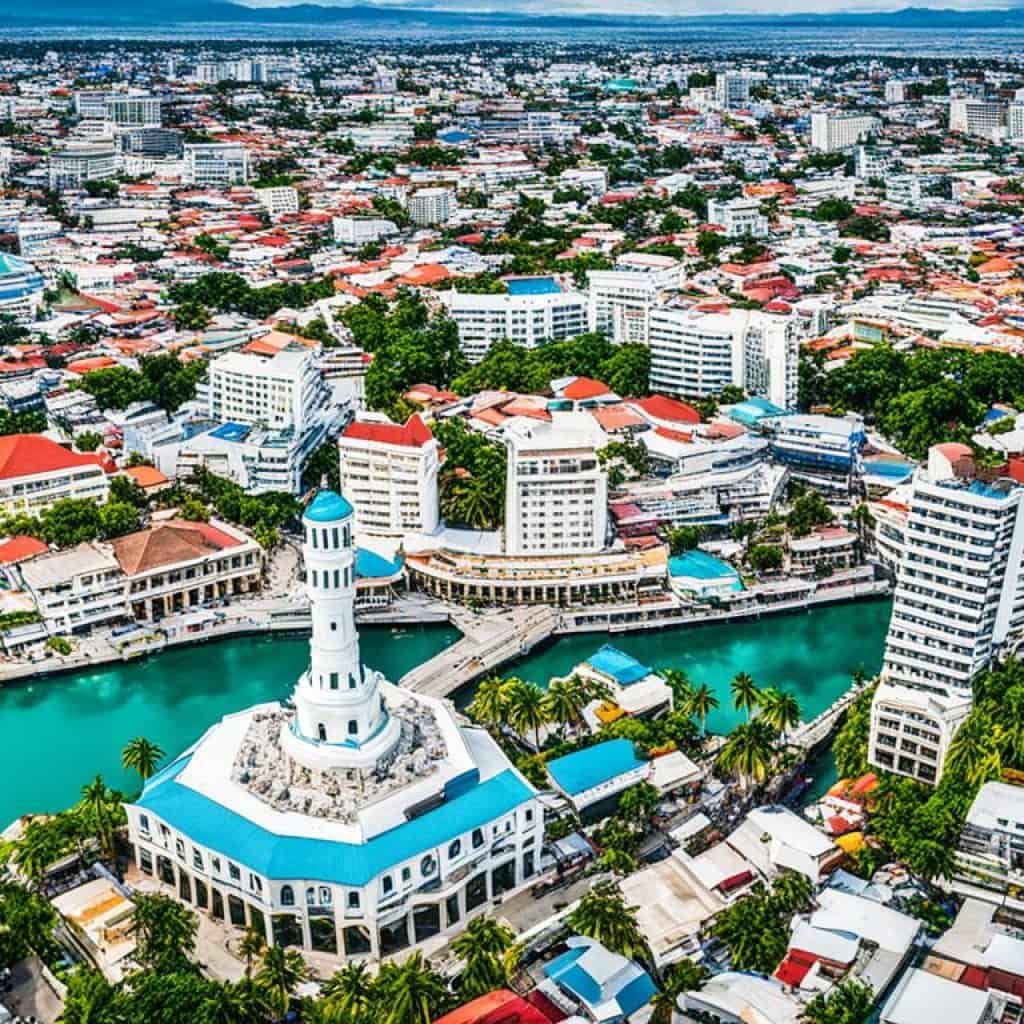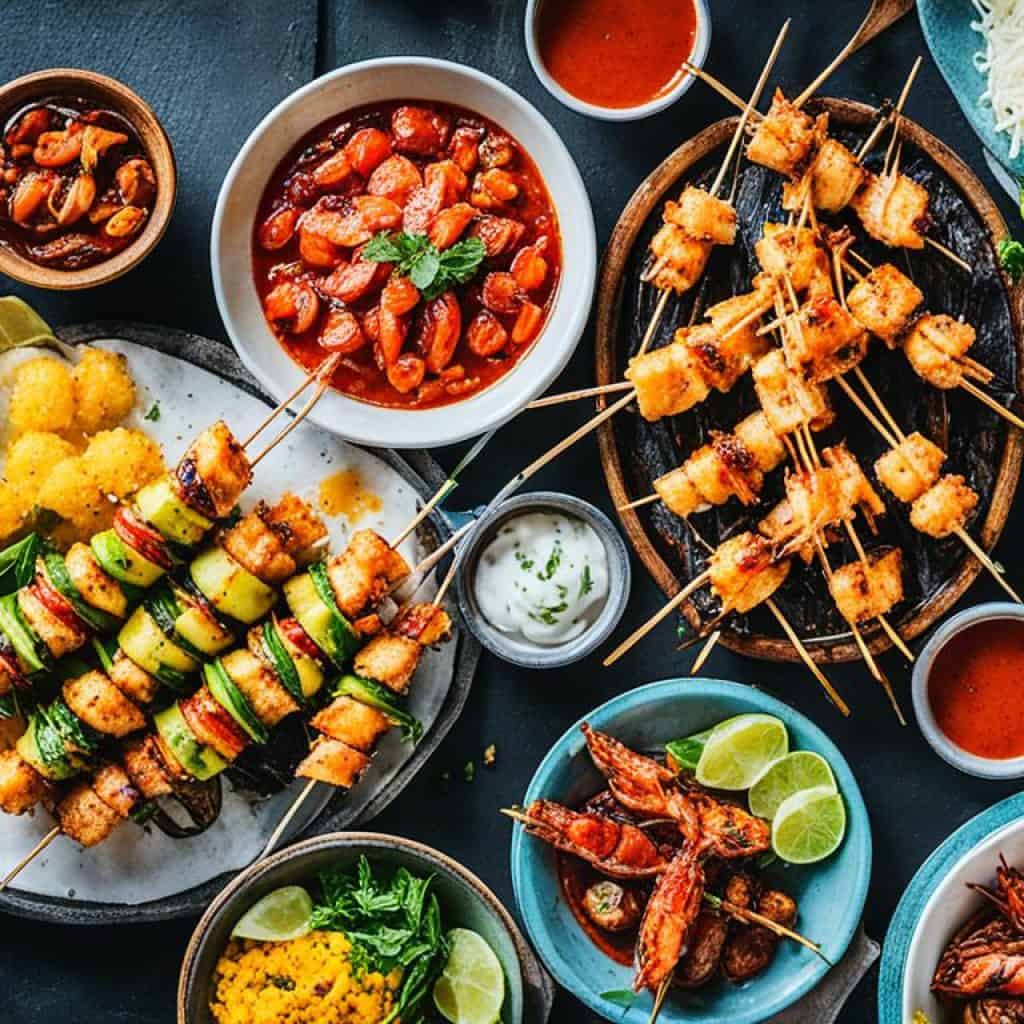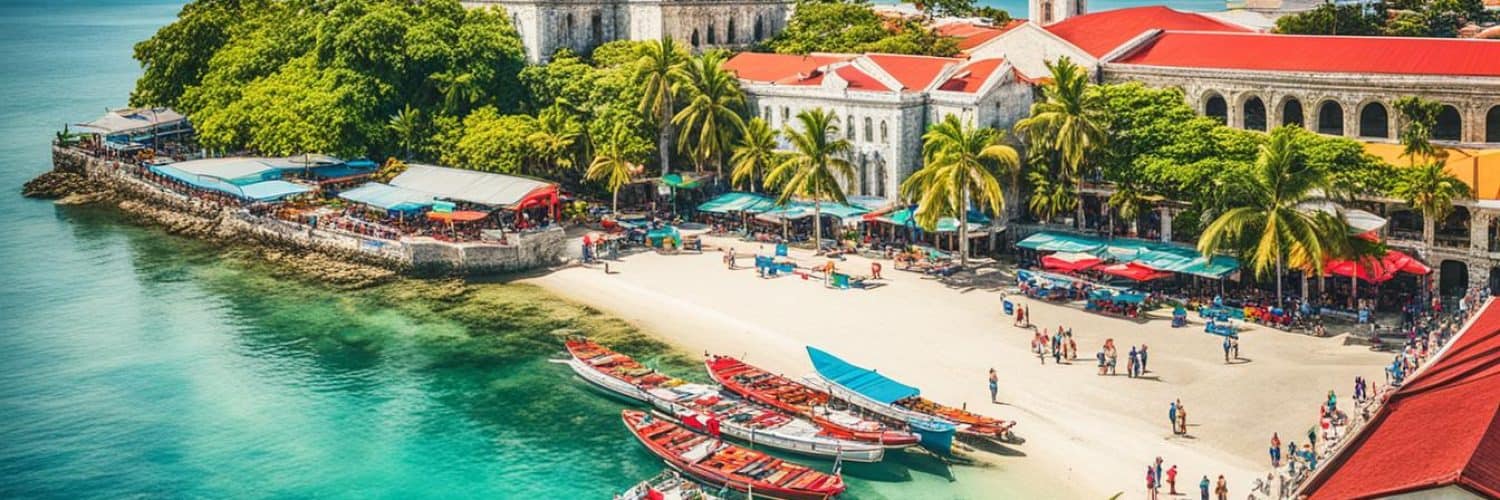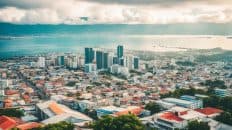Have you ever wondered about the hidden gems of the Philippines? Look no further than Cebu, a city that effortlessly blends culture, history, and natural beauty. As you navigate through this vibrant city, you’ll be greeted by graceful Spanish colonial architecture, breathtaking landmarks, and a warm, welcoming community. But what makes Cebu truly captivating? Let’s dive into its background and discover the fascinating stories that make this city a must-visit destination.
Key Takeaways:
- Cebu is a vibrant city in the Philippines, known for its culture, history, and attractions.
- The city offers a unique glimpse into its Spanish heritage and the vibrant way of living of its locals.
- Cebu boasts iconic landmarks, a thriving tourism industry, and stunning natural beauty.
- Exploring Cebu means immersing yourself in its rich history, vibrant festivals, and unique culinary delights.
- Plan your visit to Cebu and get ready to be captivated by its charm and warm hospitality.
History of Cebu
Cebu, with its rich cultural heritage and historical significance, has a fascinating history dating back to the 16th century. It was in 1521 when Ferdinand Magellan, a Portuguese explorer, landed on the shores of Cebu. The blood compact he made with Humabon, the chief of Cebu, marked the beginning of Spain’s colonization and the introduction of Christianity in the Philippines. This event holds great significance in the history of Cebu and the entire country.
As the capital of Spanish colonial rule in the Philippines, Cebu played a vital role in shaping the nation’s identity. The city became a center of trade, commerce, and education, attracting settlers and immigrants from various parts of the world. Its strategic location made it a significant hub for maritime trade, strengthening the city’s economic prosperity.
“Cebu has witnessed the birth of a new era in the Philippines, with the arrival of Magellan and the subsequent Spanish colonization. Its history is a testament to the resilience and adaptability of its people.”
The Spanish influence can still be seen today in Cebu’s architecture, traditions, and religious practices. The Basilica Minore del Santo Niño, built in the 16th century, stands as a symbol of Cebu’s deep-rooted Catholic faith. It houses the famous Santo Niño image, which is venerated by millions of devotees during the Sinulog Festival, one of the grandest festivals in the Philippines.
Throughout the centuries, Cebu has faced various challenges, including natural disasters and conflicts, but it has always managed to rise above and rebuild. Today, the city stands as a vibrant and thriving metropolis, welcoming visitors from around the world to experience its rich history and cultural heritage.
The Significance of Cebu’s History
The history of Cebu is not just confined to its past but continues to shape its present and future. It serves as a reminder of the resilience and strength of its people, who have overcome adversities and embraced progress. Cebu’s historical sites, such as Magellan’s Cross and Fort San Pedro, attract tourists and locals alike, offering a glimpse into the city’s storied past.
Moreover, Cebu’s historical significance has helped establish it as one of the leading cultural and tourism destinations in the Philippines. The city’s rich heritage, combined with its modern infrastructure and warm hospitality, attracts travelers from all walks of life. Whether it’s exploring historical landmarks, immersing in local traditions, or enjoying culinary delights, Cebu offers a unique and unforgettable experience to its visitors.
| Key Events | Significance |
|---|---|
| Ferdinand Magellan’s Landing | Marked the beginning of Spanish colonization and the introduction of Christianity in the Philippines |
| Spanish Colonial Capital | Cebu served as the capital of Spanish colonial rule in the Philippines, shaping the nation’s identity |
| Trade and Commerce Hub | Cebu’s strategic location made it a significant center for maritime trade and economic prosperity |
| Religious Significance | Cebu’s deep-rooted Catholic faith is showcased in its religious sites and practices |
| Resilience and Rebuilding | Despite challenges, Cebu has overcome and rebuilt, demonstrating the strength of its people |
Culture of Cebu
Cebu’s culture is a vibrant fusion of indigenous Filipino traditions and Spanish influences. This unique blend is reflected in the city’s diverse festivals, rich artistic heritage, and strong sense of community. Cebuanos take great pride in preserving their cultural identity and showcasing it to the world.
The Sinulog Festival is the epitome of Cebu’s cultural vibrancy. Celebrated every third Sunday of January, it is a grand spectacle of color, music, and dance. The festival pays homage to the Santo Niño, the child Jesus, and features lively street processions and captivating performances. Visitors flock to Cebu during this time to witness the Sinulog Festival’s magnificence and experience the infectious joy that fills the city.
“The Sinulog Festival is a testament to Cebu’s rich heritage and unwavering devotion to its religious traditions.”
Music and dance play a vital role in Cebuano culture. Traditional dances such as the Tinikling and the Kuradang showcase the grace and elegance of Cebu’s folk traditions. Local artists and musicians infuse their crafts with the essence of Cebu, creating a vibrant tapestry of sounds and rhythms. Whether it’s the soulful notes of a Cebuano love song or the hypnotic beat of a drum, music unites the people of Cebu and keeps their cultural heritage alive.
The visual arts hold a special place in Cebu’s cultural landscape. From centuries-old religious sculptures to contemporary paintings, Cebu is a treasure trove of artistic expression. One iconic symbol of Cebu’s artistic heritage is the Cebu Heritage Monument, located at the heart of the city. This masterpiece immortalizes key historical events and figures, showcasing the resilience and creativity of the Cebuanos.
The culture of Cebu is also deeply rooted in its people’s warm hospitality and strong sense of community. Cebuanos are known for their genuine kindness and willingness to welcome strangers as friends. The concept of “bayanihan,” a communal unity and cooperation, is a core value that binds the people of Cebu together.
Experience the rich culture and heritage of Cebu through its festivals, arts, and warm hospitality. Immerse yourself in the vibrant energy of the Sinulog Festival, witness the craftsmanship of local artists, and connect with the local community to truly appreciate the essence of Cebu’s culture.
Exploring Cebu’s Cultural Gems
To delve deeper into Cebu’s cultural tapestry, here are some must-visit sites:
| Sites | Description |
|---|---|
| Magellan’s Cross | A historical landmark that symbolizes the arrival of Spanish explorers to the Philippines and represents the introduction of Christianity. |
| Casa Gorordo Museum | A beautifully preserved ancestral home that provides a glimpse of upper-class Cebuano life during the Spanish colonial era. |
| Lapu-Lapu Shrine | A tribute to Lapu-Lapu, the native chieftain who led the resistance against Ferdinand Magellan’s forces during the Battle of Mactan. |
| Taoist Temple | A serene and ornate temple that showcases the influence of Chinese culture in Cebu. |
| University of San Carlos Museum | Home to a vast collection of religious art and artifacts, offering a deeper understanding of Cebu’s religious roots. |
Experience the rich cultural tapestry of Cebu, where traditions are cherished and celebrated, and the warmth of its people leaves a lasting impression.
Cebu Landmarks and Attractions
Cebu is renowned for its stunning landmarks and attractions that showcase its rich history and cultural significance. Whether you’re a history buff, an architecture enthusiast, or simply looking to immerse yourself in the beauty of this vibrant city, Cebu has something for everyone. Here are some of the must-visit landmarks and attractions in Cebu:
Magellan’s Cross
One of the most iconic symbols of Cebu, Magellan’s Cross holds great historical significance. Located in Plaza Sugbo, this cross marks the spot where Ferdinand Magellan planted a cross upon his arrival in the Philippines in 1521. It is a testament to Cebu’s role in the country’s colonial past and is a popular destination for tourists and locals alike.
Fort San Pedro
A visit to Cebu wouldn’t be complete without exploring Fort San Pedro, the country’s oldest and smallest fort. Built in the 16th century, this historic fort served as a defense structure during the Spanish colonial period. Today, it stands as a tangible reminder of Cebu’s rich history and offers visitors a glimpse into the city’s past.
Cebu Heritage Monument
The Cebu Heritage Monument is a masterpiece that depicts significant events in the history of Cebu. Located in Parian, this stunning monument showcases the city’s journey from its pre-Spanish era to the present day. It is a tribute to the resilience and cultural heritage of the Cebuanos, inviting visitors to delve deeper into the city’s history.
Yap-Sandiego Ancestral House
The Yap-Sandiego Ancestral House is a well-preserved heritage house that provides a glimpse into Cebu’s colonial past. Built in the late 17th century, this ancestral house showcases the architectural style and lifestyle of the Filipino-Chinese families during that era. It is now a museum that houses a collection of antiques and artifacts, giving visitors a unique perspective on Cebu’s cultural heritage.
Mactan Shrine
Located in Lapu-Lapu City, the Mactan Shrine commemorates the Battle of Mactan, one of the most significant events in Philippine history. It is dedicated to Lapu-Lapu, the native chieftain who led the Filipino warriors against the Spanish forces led by Magellan. The shrine features a towering statue of Lapu-Lapu and serves as a reminder of the bravery and heroism of the Filipinos.
These are just a few of the many landmarks and attractions that make Cebu a captivating destination. Whether you’re exploring the city’s historical sites, admiring its architectural wonders, or delving into its cultural heritage, Cebu offers a unique and enriching experience that will leave you with lasting memories.
Cebu’s Thriving Tourism Industry
Cebu, the vibrant city located on Cebu Island’s eastern coast in the south-central Philippines, is not only rich in culture, history, and breathtaking attractions but also a popular tourist destination that attracts visitors from around the world.
With its well-developed tourism industry, Cebu offers a wide range of accommodations, restaurants, and tour operators catering to the needs of travelers. Whether you prefer luxurious resorts or budget-friendly guesthouses, Cebu has something for everyone.
The city’s attractions are a major draw for tourists. Cebu is famous for its pristine beaches and crystal-clear waters, making it a paradise for beach lovers and water sports enthusiasts. From swimming and snorkeling to diving and island hopping, you can explore the captivating beauty of Cebu’s coastline.
For history enthusiasts, Cebu boasts a wealth of historical landmarks that reflect its cultural heritage. Visit the iconic Magellan’s Cross, Fort San Pedro, and the Cebu Heritage Monument to delve into the city’s storied past.
Immerse yourself in the vibrant festivals and celebrations that take place throughout the year. The Sinulog Festival, held in January, is a grand display of colorful costumes, dances, and religious processions that honor the Santo Niño.

The thriving tourism industry in Cebu ensures that there are plenty of activities and attractions for everyone. Whether you’re interested in exploring historical sites, indulging in delicious cuisine, or experiencing the warm hospitality of the locals, Cebu is sure to leave you with lasting memories.
| Reasons to Visit Cebu | Popular Attractions |
|---|---|
| Rich culture and history | Magellan’s Cross |
| Pristine beaches and diving spots | Bantayan Island |
| Vibrant festivals and celebrations | Sinulog Festival |
| Delicious cuisine and unique flavors | Cebu lechon |
| Warm hospitality and friendly locals | Larsian Barbecue |
Economic Significance of Cebu
Cebu, with its vibrant tourism industry and diverse attractions, plays a crucial role in the economy of the Philippines. One of the key drivers of this significance is its bustling port, which serves as a major hub for trade and commerce.
The port of Cebu facilitates the transport of a variety of interisland commodities, including copra, abaca, sugar, timber, and fish. This robust trade network contributes to the economic growth and stability of the region, attracting business opportunities and fostering employment in various sectors.
In addition to its thriving port, Cebu is a vital point of passenger traffic. The city is home to an international airport that welcomes travelers from various destinations, further boosting its economic activity. The influx of tourists and business travelers to Cebu contributes to the growth of the hospitality, transportation, and service industries.
Cebu’s economic significance extends beyond its port and tourism sector. The city is also a center for manufacturing and wholesale trade. It houses industrial complexes and factories that produce a wide range of products, including garments, furniture, electronics, and food processing. These industries generate employment opportunities and contribute to the overall economic development of the region.
With its strategic location, vibrant tourism industry, and diverse economic sectors, Cebu continues to thrive as a key player in the Philippines’ economy. Its dynamic and robust business environment makes it an attractive destination for investors, entrepreneurs, and visitors alike.
Education in Cebu
Cebu, the center of education in the Philippines, boasts a diverse range of universities that attract students from all over the country and internationally. These esteemed institutions provide a gateway to knowledge and learning, offering a wide array of courses and programs to suit various academic interests and career paths.
Some of the leading educational institutions in Cebu include:
- University of San Carlos
- Cebu Institute of Technology
- Southwestern University
- University of the Southern Philippines
- University of the Visayas
These universities have established themselves as pillars of higher education, consistently delivering quality education and fostering academic excellence. Students can choose from a vast range of disciplines, including business, engineering, medicine, arts, and sciences.
Moreover, the universities in Cebu provide a supportive and enriching environment for students, offering state-of-the-art facilities, experienced faculty, and opportunities for research and extracurricular activities. These institutions prioritize holistic development, nurturing students’ intellectual, social, and personal growth.
Studying in Cebu offers students a unique cultural experience, as they immerse themselves in the vibrant local community while pursuing their academic goals. The city’s rich history, cultural heritage, and warm hospitality provide a conducive environment for personal and educational growth.
Whether students are looking to pursue undergraduate or postgraduate studies, Cebu’s universities offer a wide range of opportunities for academic advancement and professional development. With their commitment to excellence, these institutions serve as beacons of education, molding the minds of future leaders and contributing to the intellectual development of the nation.
Cebu’s Resilience
Cebu has shown incredible resilience throughout its history, overcoming various challenges and disasters. The city has experienced earthquakes, typhoons, and other natural calamities, but it has always managed to rebuild and recover. The resilience of its people and their strong community spirit have played a vital role in overcoming adversity and shaping the city’s future.
Despite the destruction caused by disasters, Cebu has proven time and again that it can rise above the challenges it faces. The city’s determination to rebuild and restore its infrastructure reflects the indomitable spirit of its residents. From reconstructing historical landmarks to reviving local businesses, Cebu has demonstrated its resilience in the face of adversity.
One example of Cebu’s resilience is seen in its recovery from the devastating earthquake that struck the region in 2013. The tremor, with a magnitude of 7.2, caused significant damage to buildings, roads, and other infrastructure. However, the people of Cebu united to rebuild their city, showing remarkable resilience and determination. Today, Cebu stands strong, with restored structures and a revitalized community.
“Cebuanos have always been known for their resilience. The way we bounce back from disasters is a testament to our strength and unity as a community.” – Mayor of Cebu City
Another example of Cebu’s resilience is evident in the recovery of its tourism industry after the challenges posed by the global pandemic. With its vibrant tourism sector severely affected by travel restrictions and lockdowns, Cebu adapted swiftly to the changing circumstances. The city implemented strict protocols to ensure the safety of residents and visitors, enabling it to gradually reopen and revive its tourism industry.
Cebu’s resilience extends beyond physical recovery. It is a testament to the city’s ability to adapt, innovate, and evolve. The people of Cebu have consistently shown their resourcefulness and creativity in finding solutions to challenges. From establishing community-based initiatives to supporting local businesses, Cebuanos have proven their determination to thrive in the face of adversity.
Cebu’s resilience is not only seen in its ability to recover from disasters but also in its continuous development and progress. The city continues to attract investments, foster entrepreneurship, and promote sustainable development. With its strong economic foundation and dynamic workforce, Cebu remains a resilient and forward-thinking city.
As Cebu moves forward, its resilience will continue to be a driving force behind its success. The lessons learned from the past will shape its future and ensure that the city remains prepared to face any challenges that come its way.
| Key Factors of Cebu’s Resilience | Examples |
|---|---|
| Strong community spirit | Collaborative efforts in rebuilding after disasters |
| Adaptability and innovation | Implementing new technologies and strategies to address challenges |
| Resourcefulness | Development of community-based initiatives and support for local businesses |
| Economic stability | Attracting investments and fostering entrepreneurship |
Unique Flavors of Cebu
Cebu, a city in the Philippines, is renowned for its unique flavors and mouthwatering cuisine. Visitors to Cebu are in for a treat as the city offers a wide range of culinary delights that showcase its rich gastronomic heritage. From savory dishes to delightful snacks, Cebu’s delicacies are sure to satisfy even the most discerning food lover.
One of the most famous dishes in Cebu is the Cebu lechon, a succulent roasted pig that is known for its crispy skin and tender meat. It is widely regarded as one of the best lechons in the country, and locals take pride in its flavorful taste and expertly cooked texture.
Apart from the iconic lechon, Cebu is also known for its dried mangoes. These sweet and tangy dried fruits are a popular snack, loved not just by locals but by visitors from around the world. Cebu’s unique climate and fertile soil contribute to the exquisite flavor and delightful chewiness of the mangoes.
“Cebu is a food lover’s paradise. Whether you’re exploring the bustling streets or dining in one of its many restaurants, you’ll be greeted by an array of flavors that truly reflect the city’s culinary heritage.”
Another must-try delicacy in Cebu is chicharon, crispy pork cracklings that are a true indulgence. These crunchy snacks are a favorite among locals and visitors alike, offering a satisfying combination of texture and flavor.
For seafood enthusiasts, sutukil is a must-try dish. It is a unique combination of grilled, boiled, and raw seafood, allowing diners to experience a variety of flavors and textures in one meal. From tender grilled fish to succulent boiled shrimps and fresh raw shellfish, sutukil showcases the abundance of marine delights in Cebu.
Discover the Flavors of Cebu
When visiting Cebu, exploring its culinary scene is a must-do. Whether you are strolling through the vibrant markets, dining in local eateries, or indulging in fine dining restaurants, be prepared to embark on a flavorful journey that will tantalize your taste buds.
| Cebu Delicacies | Description |
|---|---|
| Cebu Lechon | A roasted pig with crispy skin and tender, flavorful meat. |
| Dried Mangoes | Sweet and tangy dried mango slices, perfect for snacking. |
| Chicharon | Crispy pork cracklings, a popular local snack. |
| Sutukil | A combination of grilled, boiled, and raw seafood, offering a diverse seafood experience. |
These are just a few of the many culinary delights that await you in Cebu. Don’t miss the chance to savor these unique flavors and experience the richness of Cebu’s cuisine. Your taste buds will thank you.

Cebu’s Natural Beauty
Cebu is a breathtaking destination that showcases the natural beauty of the Philippines. From its pristine beaches to its lush mountains and majestic waterfalls, Cebu offers a paradise for outdoor enthusiasts and nature lovers.
One of the best ways to explore Cebu’s natural wonders is through island hopping. Hop aboard a boat and discover the picturesque islands surrounding Cebu, each with its own unique charm and breathtaking landscapes. Explore secluded beaches, snorkel in crystal-clear waters, and soak up the sun in paradise.
For those seeking adventure, Cebu offers thrilling activities like snorkeling and diving. Dive into vibrant coral reefs teeming with marine life, including the breathtaking Oslob Whale Sharks. Swim alongside these gentle giants and create unforgettable memories.
If hiking is more your style, Cebu has an abundance of scenic trails waiting to be explored. Trek through lush mountains and immerse yourself in the beauty of nature. From challenging climbs to leisurely walks, there’s a hiking trail for every skill level.
Canyoneering in Cebu is a thrilling experience that combines hiking, swimming, and cliff jumping. Explore stunning canyons, conquer cascading waterfalls, and feel the rush of adrenaline as you leap into natural pools. It’s an adventure you won’t soon forget.
Some of the must-visit natural attractions in Cebu include the enchanting Kawasan Falls, known for its turquoise waters and lush surroundings. Immerse yourself in nature’s beauty as you swim in the refreshing pools or take a bamboo raft ride under the waterfalls.
The Oslob Whale Sharks are another popular attraction in Cebu. These gentle giants migrate to the area, and visitors have the unique opportunity to swim with them in their natural habitat. It’s an awe-inspiring experience that showcases the wonders of marine life.
Malapascua Island is renowned for its pristine beaches and vibrant marine ecosystem. Relax on the white sands, go snorkeling or diving to explore the colorful coral reefs, or take a boat tour to nearby diving spots such as Monad Shoal, known for its thresher sharks.
Explore the beauty of Cebu’s natural landscapes and you’ll be captivated by its diverse ecosystems. It’s a destination that will leave you in awe of Mother Nature’s wonders.
| Popular Natural Attractions in Cebu | Description |
|---|---|
| Kawasan Falls | A stunning series of waterfalls with turquoise pools, perfect for swimming and bamboo rafting. |
| Oslob Whale Sharks | Get up close and personal with majestic whale sharks as you swim with them in their natural habitat. |
| Malapascua Island | Experience pristine beaches, vibrant coral reefs, and the chance to spot thresher sharks on a diving adventure. |
Cebu’s Festivals and Celebrations
Cebu is renowned for its vibrant festivals and celebrations that immerse visitors in the rich cultural heritage and religious traditions of the city. Among these, the Sinulog Festival stands out as the most famous and widely celebrated festival in Cebu. Held every January, it is a grand spectacle of colors, music, and dance, paying homage to the Santo Niño, or the Child Jesus.
The Sinulog Festival is characterized by its lively street dances, where performers clad in vibrant and elaborate costumes fill the streets, showcasing their synchronized movements. The beat of traditional drums and the sound of joyful chants create an infectious atmosphere of celebration. Religious processions also play a significant role in the festival, as devotees offer prayers and gratitude to the Santo Niño.
“The Sinulog Festival is not just a mere spectacle but a manifestation of faith and devotion.”
In addition to the Sinulog Festival, Cebu is home to other notable festivals that offer unique insights into Cebuano culture. The Kadaugan sa Mactan festival commemorates the historic Battle of Mactan, showcasing reenactments of the events that led to the victory of Lapu-Lapu, the local chieftain, against the Spanish expedition led by Ferdinand Magellan. It is a celebration of Lapu-Lapu’s heroism and the triumph of indigenous resistance.
Pasko sa Sugbo, or Christmas in Cebu, is a festive celebration of the holiday season, marked by vibrant decorations, nightly performances, and bazaars. The city comes alive with the spirit of Christmas, spreading joy and creating a magical atmosphere for both locals and visitors.
The Kadaugan Street Party is another exciting event that showcases Cebu’s festive spirit. Held in Lapu-Lapu City, this street party brings together music, food, and dance performances, creating a lively and enjoyable experience for attendees.
These festivals and celebrations reflect the vibrant culture and deep-rooted traditions of Cebu. They provide visitors with an immersive experience, allowing them to witness the city’s rich heritage and the spirited nature of its people, making Cebu an unforgettable destination.
The Sinulog Festival showcases the vibrant colors and lively street dances of Cebu.
Cebu’s Contribution to the Philippines
Cebu, with its rich history and cultural heritage, has played a significant role in shaping the identity of the Philippines. As the country’s oldest settlement and a major Spanish colonial capital, Cebu served as a center of trade, education, and religion, leaving a lasting impact on the development of the nation.
“Cebu’s contribution to the Philippines cannot be understated. It served as an important hub for international trade, connecting the Philippines to the global market. The Spanish colonizers established Cebu as their base, bringing with them Catholicism and laying the foundation for the country’s enduring religious traditions.”
The cultural influence of Cebu is evident in its vibrant festivals and celebrations, where locals express their devotion to their Catholic faith. Visitors can witness the grandeur of these festivities, such as the Sinulog Festival, which showcases the city’s deep-rooted religious traditions and colorful street dances.
Cebu’s educational institutions have also made significant contributions to the country’s intellectual growth. Universities like the University of San Carlos and the Cebu Institute of Technology have produced countless graduates who have excelled in various fields, contributing to the advancement of the Philippines.
Impact on Trade and Commerce
Cebu’s strategic location and bustling port have made it a crucial center for trade and commerce. The city has been instrumental in the transportation of goods, both domestically and internationally. Its strategic position in the Visayas region has attracted businesses from different industries, contributing to the economic growth of the Philippines.
Preservation of Cultural Heritage
Cebu takes pride in its rich cultural heritage, which has been preserved and celebrated by its people. The city’s historical landmarks, such as Magellan’s Cross and Fort San Pedro, serve as reminders of its colonial past and provide valuable insights into the history of the Philippines.
Furthermore, Cebu’s creative industries, including traditional crafts and performing arts, contribute to the promotion and preservation of Filipino culture. Artisans and performers showcase their skills and talents, allowing visitors to experience the beauty and uniqueness of Cebuano traditions.
| Contributions | Description |
|---|---|
| Trade and Commerce | Cebu’s bustling port serves as a major hub for domestic and international trade, facilitating the transportation of goods and stimulating economic growth. |
| Educational Excellence | Cebu’s universities provide quality education and produce graduates who contribute to the intellectual and professional sectors of the Philippines. |
| Preservation of Cultural Heritage | Through historical landmarks and vibrant festivals, Cebu celebrates and preserves its rich cultural heritage, promoting Filipino traditions. |
With its significant contributions to the history, culture, and economy of the Philippines, Cebu continues to be a source of pride for Filipinos and a destination that showcases the best of the country’s heritage and traditions.
Conclusion
Cebu’s background is a vibrant tapestry of culture, history, and attractions that captivate travelers from around the world. With its rich history and cultural heritage, Cebu offers a unique glimpse into its Spanish colonial past and the vibrant way of living of its locals. From iconic landmarks like Magellan’s Cross and Fort San Pedro to the breathtaking natural beauty of its beaches and waterfalls, Cebu has something to offer everyone.
Immerse yourself in the warm hospitality and strong sense of community that Cebuanos are known for. Indulge in the unique flavors of Cebu’s cuisine, from the famous Cebu lechon to the mouthwatering chicharon. Experience the vibrancy of Cebu’s festivals and celebrations, where colorful costumes and lively street dances showcase the city’s rich cultural heritage.
Plan your visit to Cebu and discover the wonders of this captivating city. Whether you’re a history buff, a nature lover, or a food enthusiast, Cebu will leave you spellbound with its charm and beauty. Explore the diverse attractions, savor the delightful flavors, and create unforgettable memories in this enchanting destination.


















Add comment